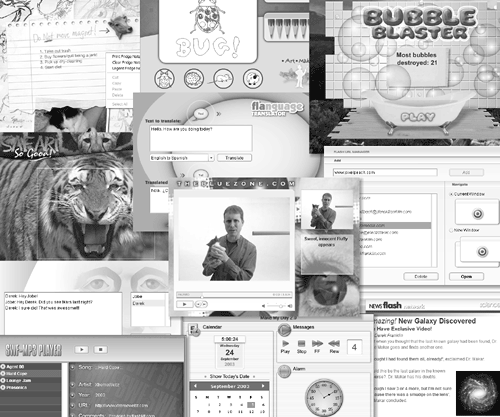introduction
introduction
ActionScript is the programming language that enables you to use Macromedia's popular Flash to create highly interactive multimedia-based Web sites, product demos, teaching materials, and more. If you're familiar with the logic of other programming languages, especially JavaScript or Java, ActionScript will seem quite familiar. After you've learned the logic behind how scripting works, as well as the many things it allows you to create and do, chances are you'll wish you had started sooner. Creativity isn't reserved for artists and designers, after all; scripting is another form of creativity, and equally as rewarding. With a thorough knowledge of ActionScript, you can express yourself in many ways you may never have imagined.
This Training from the Source course introduces you to the major elements of ActionScript by guiding you through a wealth of step-by-step projects that thoroughly explain not only what's happening, but also why and how. The focus of each project is the teaching of ActionScript; therefore, in nearly all the projects, most graphical elements and other objects not directly related to the lesson are already set up for you. Their purpose in the project, as well as brief descriptions of what they do (if necessary), are always included.
Now that there are two versions of Flash (Standard and Professional), it was a fine balancing act to make this book appealing and useful to users of either version. To that end, users of both versions can benefit from the majority of this book, although there are several lessons that make use of components and functionalities found only within the Professional version.
The curriculum of the course is approximately 2630 hours in length and includes the following lessons:
Lesson 1: Introducing ActionScript
Lesson 2: Using Event Handlers
Lesson 3: Understanding Target Paths
Lesson 4: Using Object Classes
Lesson 5: Using Functions
Lesson 6: Creating and Manipulating Data
Lesson 7: Creating Custom Classes
Lesson 8: Using Conditional Logic
Lesson 9: Automating Scripts with Loops
Lesson 10: Scripting UI Components
Lesson 11: Getting Data In and Out of Flash
Lesson 12: Using XML with Flash
Lesson 13: Validating Data
Lesson 14: Working with Text Fields
Lesson 15: Controlling Movie Clips Dynamically
Lesson 16: Time- and Frame-Based Dynamism
Lesson 17: Scripting for Sound
Lesson 18: Loading External Assets
Lesson 19: Testing and Debugging
Lesson 20: Maximum-Strength SWFs
Lesson 21: Printing and Context Menus
This book contains more than 40 separate projects, each designed to teach you a specific aspect of ActionScript. These projects are fun, useful, and practical examples of how ActionScript can be used in real-world situations.
Each lesson begins with an overview of the lesson's content and learning objectives. Lessons are divided into individual tasks that help you learn and utilize various aspects of the lesson's topic.
This book is part of the Training from the Source series. It contains conceptual information, in-depth material, and step-by-step explanations. In addition, each lesson includes the following special features:
Special font for code: To help you easily identify ActionScript, XML, and HTML code within the book, the code has been styled in a special font that's unique from the rest of the text.
Bold text: Bold text is used to identify the names of visual elements in a project, including movie clips, buttons, and text fields.
Tips: Tips contain shortcuts for carrying out common tasks, and ways you can use the skills you're learning to solve common problems.
Notes: Notes provide additional information pertaining to the task at hand.
Appendix: The Appendix contains a list of Flash resources related to many aspects of using Flash, including scripting, design, animation, and usability.
This course is developed to help you build your skills progressively as you work through each lesson. When you've completed the entire course, you'll have a thorough knowledge of ActionScript, including its syntax, capabilities, and the logic behind the way to make it do what you want it to do. As a result, you have the skills necessary to create dynamic, highly interactive Flash content.
The accompanying CD contains all the files necessary to complete each lesson. Files for each lesson appear in a folder titled with the lesson number. It is strongly suggested that you create a folder on your hard drive and transfer all lesson files to that folder prior to beginning the course. The reason is that you'll occasionally be asked to test your work using Flash's Test Movie command. This command creates a test file in the same directory as the Flash file that is being authored. If the authored file was opened from the CD, Flash will attempt to create the test movie on the CD. In almost all cases, this is impossible and will result in an error.
Each lesson folder contains two subfolders: Assets and Complete. The Assets folder contains any media files and initial Flash files needed for the lesson. The files you need are identified at the beginning of each lesson. The Complete folder contains completed files for each step in the project so that you can compare them to your own work or see where you're headed.
The lessons in this book assume that the following statements are true:
You're familiar with using menus, opening and saving files, and so on for either the Windows or Macintosh operating system.
Flash MX 2004 (Standard or Professional) is already installed on your machine.
Your computer meets the system requirements listed in the following section.
You're generally familiar with Flash's interface, movie and authoring concepts, creating and using movie elements, using the timeline, using basic actions, and working with the Actions panel. If you're not comfortable with any of these tasks, be sure to check out other books from Macromedia Press and Peachpit Press.
A collage of some of the many projects you will script in this course.








